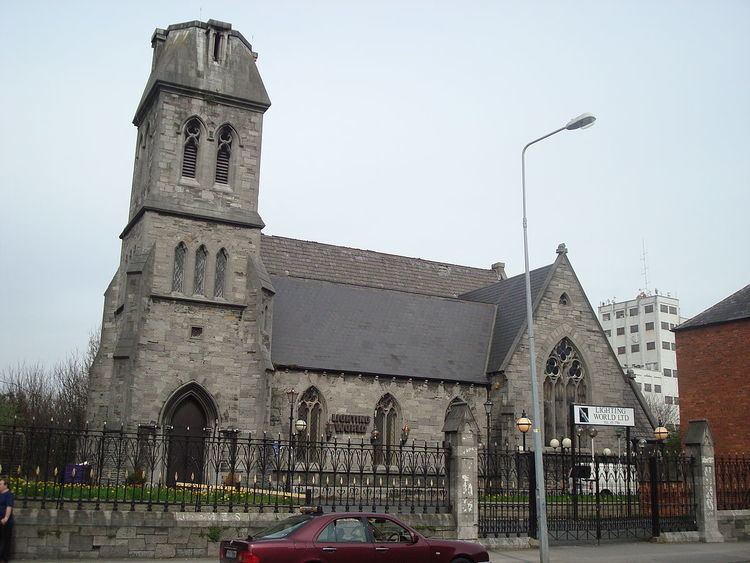Dedication St. James | Founded 1707 Status De-consecrated | |
 | ||
St. James' Church (Irish: Eaglais Naomh Séamais), a former Church of Ireland church in James's Street, Dublin, Ireland, was established in 1707. The corresponding parish, which was separated from that of nearby St. Catherine's, was established in 1710. There had been a shrine dedicated to St. James at nearby St. James's Gate, a stopping-off point for pilgrims, since medieval times.
Contents
Church
The existing church building dates from 1859 and was designed by Joseph Welland (1798–1860). The church is now closed to the public. It is the burial place of the Rev. John Ellis, for 34 years vicar of this parish, and of William Ellis, governor of Patna, India, who was killed during a war there in 1763.
Parishes of St. James and St. Catherine
In 1177 the parish of St. James is mentioned as part of the abbey of St. Thomas (from which Thomas St. got its name), and the church of St. Catherine was a chapel-of-ease to the abbey. The boundaries of the parish of St. James were defined by St. Laurence O'Toole and extended right up to the city gate at Corn Market.
By the end of the 13th century the western suburbs had so increased in population that a separate parish was deemed necessary, which was provided for by splitting the parish of St. James and setting up an independent parish for St. Catherine's. Both parishes were still subservient to the Abbey of St. Thomas, but in 1539 the abbey was dissolved with all the monasteries by Henry VIII. In the surrender made by Henry Duffe, last Abbot, were included "the Churches of St. Catherine and St. James near Dublin." Both churches, now independent, had new curates appointed by the crown: Sir John Brace to St. Catherine's (which was shortly taken over by Peter Ledwich) and Sir John Butler to St. James. Over the following hundred years both churches passed over to the reformed church, while Roman Catholic priests led a precarious existence tending to the larger part of the population, which remained faithful to the old religion.
The parish of St. Catherine appears to have been the only viable one in the area at that time - Roman Catholics eventually got the use of a chapel in Dirty Lane (now Bridgefoot Street) towards the end of the 17th century.
The Roman Catholic parish of St. James was set up in 1724, while the Church of Ireland parish of the same name came into existence in 1710.
Both Church of Ireland parishes corresponded with the civil parishes of the same names.
Cemetery
The cemetery at the church is overgrown and is not accessible to the public. In the 18th century it had been marked out by the inhabitants of the area as a desirable cemetery for the interment of their friends. During the fair of St. James, which was held in James's Street, opposite the church-yard, they decked the graves with garlands and ornaments made of white paper.
In the centre of the cemetery is the monument of Sir Theobald Butler (1650-1720), of the Butlers of Ballyline, a prominent barrister who served as Solicitor General for Ireland and assisted in framing the articles of the Treaty of Limerick in 1691, and who advocated the Roman Catholic cause before Parliament. His monument has a Latin epitaph stating that it was erected by his eldest son "to the best of fathers." Since Butler was a Catholic, it is noteworthy that the Church of Ireland made no objection to his being buried in St. James'. The monument was restored by Colonel Augustus Butler D.L. of County Clare, his descendant in the fourth generation, in 1876.
Sir Mark Rainsford, Mayor of Dublin and owner of the brewery which was sold to Arthur Guinness, was buried in St James in 1709.
Also buried here is Sergeant-Major John Lucas, VC, who died 4 March 1892 and Sir William Haldane-Porter founder of the UK Immigration Service, who died in 1944.
Across the road from the church, in the middle of the road, is the "Fountain", an obelisk with 4 sundials with a drinking fountain at its base, built in 1790 by the Duke of Rutland, the Lord Lieutenant. It was an old custom that funeral processions passing the fountain would circle it three times before carrying on to the cemetery.
Notable parishioners
James Whitelaw (1749–1813) was a clergyman at this church, before going on to St. Catherine's Church.
